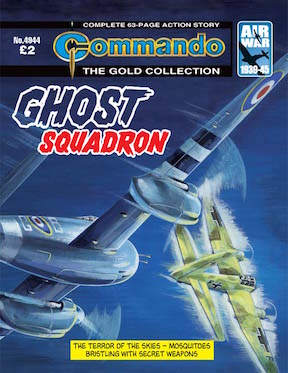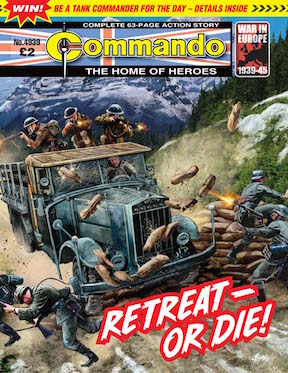Commando issues 4943-49446 – On Sale 25 August 2016
Ice-Cold Combat — Commando No 4943

When their Handley Page Hampden bomber was shot down, Pilot Officer Drew Grange and Sergeant Adam Weir were stranded on the icy border between Norway and Russia.
Helped by a couple of civilian hunters, the R.A.F. men were soon embroiled in a fight for survival. Finding an unarmed, abandoned Tiger Moth ski-plane, they took to the skies above the remote, frozen frontier in a desperate attempt to get warn their allies of an imminent Nazi threat.
Story: George Low Art: Manuel Benet Cover: Manuel Benet
Ghost Squadron — Commando No 4944

Flak, machine-guns, searchlights, enemy fighters – these the Nazi pilots knew and could handle. These things were dangerous, all right – but they didn’t turn a man’s blood to ice water in his veins, they didn’t paralyse his hands on the controls in utter, freezing terror…
But the new weapon used by the RAF night-fighters – The “Ghost Squadron” – put the fear of death into every Nazi pilot unlucky enough to come within its range.
Introduction
In this book there are several worthy ingredients which make for a satisfying Commando yarn: We have a glory-hunting pilot – Flight Lieutenant Buck Lee, determined to notch up as many kills as possible in his Mosquito bomber; the story title hints at supernatural activity; and we soon discover that some kind of shadowy, top secret, experimental weapon is also involved.
This is a great adventure, with Boutland’s script brought vividly to life by Quesada’s art and Buccheri’s eerie cover.
Scott Montgomery, Deputy Editor
Ghost Squadron, originally Commando No 247 (February 1967), re-issued as No 895 (December 1974)
Story: Boutland Art: Quesada Cover: Buccheri
Undefeated —Commando No 4945

Troubled by a past encounter early in his career, Royal Navy Lieutenant Commander Alec Weston soon became a respected, if intense, skipper. He was determined that his submarine, HMS Undefeated, would live up to her name — therefore he pushed his crew and the vessel hard.
When ferrying a Special Boat Section assault team on a secret mission in the Mediterranean, Alec was faced with a tough decision that affected the lives of that Special Forces unit. Such was the burden of command…
Story: Steve Taylor Art: Olivera/Rodriguez Cover: Janek Matysiak
Coward in Khaki — Commando No 4946

Men’s characters don’t often change. If a man’s a crook in civilian life, he’ll probably be a crook in the army. That’s how it was with Vic Wardley.
Everyone knew him to be a crook – and a coward as well. So why would an Intelligence Corps Major single him out for a vital job in contact with the enemy?
Introduction
Very generally speaking, Commando usually deals in “heroes” and “villains”, with the battle lines clearly drawn. However, I’d venture that “Coward In Khaki” is an intriguing glimpse into what it might have been like if Commando had veered towards the anti-heroes prevalent in rival war comics like Battle and Action in their mid-1970s prime.
The story title is unscrupulous in its assessment of the eponymous character, Private Vic Wardley — we’re left in no doubt that he is an unsavoury type, to say the least — but perhaps he might change his ways by the time we reach the last page…?
Scott Montgomery, Deputy Editor
Coward In Khaki, originally Commando No 1125 (May 1977), re-issued as No 2451 (March 1991)
Story: Mike Knowles Art: Mones Cover: Ian Kennedy






